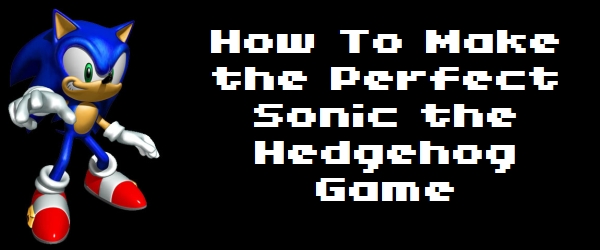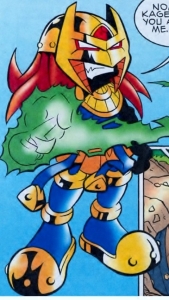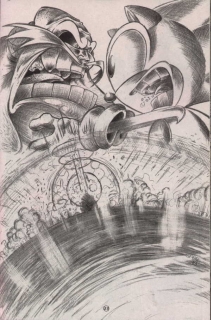
Now that Sega has announced a 20th anniversary celebration for Sonic the Hedgehog, 2011 may well prove to be an important year for their spiky blue mascot (we’ll likely get a new game out of it at least). But despite Sega’s best efforts, every gamer – casual or otherwise – knows that there hasn’t been a good Sonic the Hedgehog game made since 1994; Sonic 4 may carry on the series, but the first episode still didn’t feel perfectly right.
This lackluster feel carries on throughout all the recent games made with the title “Sonic” slapped on them, Sonic and the Black Knight included. With every attempt, Sega and Sonic Team have debatably failed to embody the traits of the original three Sonic titles for Sega Genesis (four, if you want to count Sonic and Knuckles).
The gameplay in Sonic the Hedgehog 4 was sloppy, and the camera constantly seemed zoomed-in just a bit too much. The camera should be zoomed out enough so that the player can keep up with the speed that Sonic is moving. This was an issue that I experienced when playing the Wii version of Sonic 4. I’m not sure if the other versions are different, but the Wiimote’s directional pad is the most comfortable for me to use.)
 My biggest gripe in recent Sonic games is the simplicity of the storylines. To me, everything else within a Sonic game would be bearable if the stories weren’t as farfetched or underwhelming as they seem. Without complaining too much more, Sonic games have never had a story per se, but characters have been flung in with no background or mention of where they came from. Even Shadow’s introduction in Sonic Adventure 2 left me scratching my head a little. I’ve been saying for the longest time that Sega and Sonic Team should embrace Archie Comics’ work with the Sonic the Hedgehog comic, and turn elements of that storyline into pieces of story for a new 2D, or even a 3D Sonic game. What really made the comics stand out is the foundation of the Freedom Fighters as a working group. That, along with the evolution of Robotnik into Eggman, and other notable baddies like Ixis Naugus, E.V.E., and Enerjak are what really pushed the comics forward, because these characters develop and contain personality. Simply put, they are more fearful and real than Eggman’s latest unknown schemes.
My biggest gripe in recent Sonic games is the simplicity of the storylines. To me, everything else within a Sonic game would be bearable if the stories weren’t as farfetched or underwhelming as they seem. Without complaining too much more, Sonic games have never had a story per se, but characters have been flung in with no background or mention of where they came from. Even Shadow’s introduction in Sonic Adventure 2 left me scratching my head a little. I’ve been saying for the longest time that Sega and Sonic Team should embrace Archie Comics’ work with the Sonic the Hedgehog comic, and turn elements of that storyline into pieces of story for a new 2D, or even a 3D Sonic game. What really made the comics stand out is the foundation of the Freedom Fighters as a working group. That, along with the evolution of Robotnik into Eggman, and other notable baddies like Ixis Naugus, E.V.E., and Enerjak are what really pushed the comics forward, because these characters develop and contain personality. Simply put, they are more fearful and real than Eggman’s latest unknown schemes.
One additional drawback to the modern Sonic games is the use of the targeting system, where Sonic has to dash in order to hit an obstacle or enemy. Not only is this addition unnecessary most of the time, it distracts the essence of speed that Sega and Sonic Team have always tried to give to the player. Also, half the time, the target system doesn’t work the way it’s supposed to – there’s a delay in how often the player can jump from target to target. The ideal Sonic game would drop the targeting system, allowing players to use their own judgment to cross gaps, defeat enemies, and overcome obstacles.
Sonic the Hedgehog is widely renown for its music: often fast-paced, never a dull moment. The Yamaha synthesizers used to compose the music of the Genesis titles truly have a classic sound and is nicely redone in Sonic the Hedgehog 4. Looking past the sound of Sonic 4’s music though, the composition is fairly lackluster, including a shallow mix of instruments and a lackadaisical score for most of the levels. Composition of the musical themes seemed to be an ode to the original Sonic games, which ended up sounding ripped off. The music in Sonic 4 has been a blessing compared to recent titles though, but the music in an ideal Sonic game would have a full mix while staying true to the classic synthesized sounds. The music styles would match the colors and traits of each level, including a fair bit of inspiration from that world’s boss, perhaps adding an appropriate sound effect to be triggered at certain points in the tune. Every instrument in the mix would be electronic-based, including any guitars or woodwind instruments; nothing would be acoustically recorded or modified.
In order to capture the same feel as the first titles, the ideal Sonic game would obviously have to be in 2D, though some 2.5D elements would be a nice touch as well. However, there would be no 3D aspects aside from a separated bonus stage. Without specifically re-doing the bonus stages from the first games, an idea for a 3D bonus stage could involve button-mashing. As the player quickly pressed the given buttons, Sonic would run off a ramp, shooting for distance, and would receive an item and/or extra lives based on his ending distance. An added touch might involve a slew of Robotnik’s robots underneath, where Sonic crushes a different-sized robot based on his performance.
 Now that I’m done identifying my main complaints about the last decade of Sonic games, let me step back and say a few quick things. Most of the Sonic games made since the Genesis titles haven’t been HORRIBLE. They’re… bearable, at best. When Sonic debuted on the Genesis, the franchise’s potential was huge; Sonic TV shows and comics were insightful and creative. Sonic was receiving the integrity he deserved. Unfortunately, many of the great spinoffs that erupted from the early games weren’t noticed by Sega – at least, not in the USA. The more serious Saturday morning cartoon – referred to by fans as the “SatAM” cartoon – brought about a whole new vision in the franchise, and Archie Comics writers were quick to follow up with that vision. Since then, the comics’ stories have evolved, and the art in each issue astonishingly continues to do the same, which leaves me hanging when it comes to Sega’s releases as of late. I am still a Sonic fan, and always will be – hell, I just bought another figurine yesterday. But when I see the potential of Sonic followed by its intermittent failure, it’s upsetting. Mine is among the many pleas for Sega to realize what they’ve been doing to their mascot, the character who got them to where they are now.
Now that I’m done identifying my main complaints about the last decade of Sonic games, let me step back and say a few quick things. Most of the Sonic games made since the Genesis titles haven’t been HORRIBLE. They’re… bearable, at best. When Sonic debuted on the Genesis, the franchise’s potential was huge; Sonic TV shows and comics were insightful and creative. Sonic was receiving the integrity he deserved. Unfortunately, many of the great spinoffs that erupted from the early games weren’t noticed by Sega – at least, not in the USA. The more serious Saturday morning cartoon – referred to by fans as the “SatAM” cartoon – brought about a whole new vision in the franchise, and Archie Comics writers were quick to follow up with that vision. Since then, the comics’ stories have evolved, and the art in each issue astonishingly continues to do the same, which leaves me hanging when it comes to Sega’s releases as of late. I am still a Sonic fan, and always will be – hell, I just bought another figurine yesterday. But when I see the potential of Sonic followed by its intermittent failure, it’s upsetting. Mine is among the many pleas for Sega to realize what they’ve been doing to their mascot, the character who got them to where they are now.
Sonic fans the world over have produced tons of fanmade games and images that give anything Sega’s made in the last decade a run for their money. Just look at the Sonic Fan Remix, a stylized remake of Sonic the Hedgehog 2. Sega needs to hire these guys, NOW. Not only is the artwork well-done, but there is so much attention to detail and the environments are mind-blowing:
With all that being said, the release of Sonic Colors was good for a quick pick-me-up in the grand scheme of things. Over the last ten years, though, Sega has always had something missing from each of Sonic’s adventures. Use the comment section to let us know what you would add to your “perfect” Sonic game.






